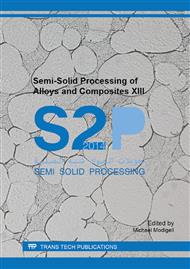[1]
D. B. Spencer. Rheology of liquid-solid mixtures of lead-tin [Ph. D Dissertation]. Cambridge, MA, USA: Massachusetts Institute of Technology; (1971).
Google Scholar
[2]
D. B. Spencer, R. Mehrabian, M. C. Flemings. Rheological behavior of Sn-15 pct Pb in the crystallization range, Metall. Trans. B 3(1972)1925-(1932).
DOI: 10.1007/bf02642580
Google Scholar
[3]
M.C. Flemings. Behavior of metal alloys in the semisolid state, Metall. Trans. B 22A(1991)957-981.
DOI: 10.1007/bf02661090
Google Scholar
[4]
S. Ji, Z. Fan, M. J. Bevis. Semi-solid processing of engineering alloys by a twin-screw rheomoulding process, Mater. Sci. Eng. A 299(2001)210-217.
DOI: 10.1016/s0921-5093(00)01373-3
Google Scholar
[5]
R. Haghayeghi, E. J. Zoqui, A. Halvaee, M. Emamy. An investigation on semi-solid Al-7Si-0. 3Mg alloy produced by mechanical stirring, J. Mater. Process. Technol. 3(2005)382-387.
DOI: 10.1016/j.jmatprotec.2005.04.071
Google Scholar
[6]
C. Vivès. Elaboration of metal matrix composites from thixotropic alloy slurries using a new magnetohydrodynamic caster. Metall. Trans. B 24b(1993)493-510.
DOI: 10.1007/bf02666433
Google Scholar
[7]
P. K. Seo, C. G. Kang, S. M. Lee. A study on reheating characteristics for thixo die casting process with electromagnetic stirring and extruded aluminum alloys and their mechanical properties, Int. J. Adv. Manuf. Technol. 43(2009)482-499.
DOI: 10.1007/s00170-008-1730-z
Google Scholar
[8]
P. Kaur, D. K. Dwivedi, P. M. Pathak. Effects of electromagnetic stirring and rare earth compounds on the microstructure and mechanical properties of hypereutectic Al–Si alloys, Int. J. Adv. Manuf. Technol. 63(2012)415-420.
DOI: 10.1007/s00170-012-3921-x
Google Scholar
[9]
K. P. Young, C. P. Kyonka, J. A. Courtois. Fine Grained metal composition, U. S . Patent 4415374. (1982).
Google Scholar
[10]
E. Parshizfard, S.G. Shabestari. An investigation on the microstructural evolution and mechanical properties of A380 aluminum alloy during SIMA process, J. Alloys Compd. 509 (2011) 9654-9658.
DOI: 10.1016/j.jallcom.2011.07.068
Google Scholar
[11]
S.Y. Lee, J.H. Lee, Y.S. Lee. Characterization of Al 7075 alloys after cold working and heating in the semi-solid temperature range, J. Mater. Process. Technol. 111(2001)42-47.
DOI: 10.1016/s0924-0136(01)00494-0
Google Scholar
[12]
D. H. Kirkwood, C. M. Sellars, L. G. Elias Boyed. Thixotropic materials. European Patent 0305375 B1 (1992).
Google Scholar
[13]
A. Bolouri, C. G. Kang. Correlation between solid fraction and tensile properties of semisolid RAP processed aluminum alloys, J. Alloys Compd. 516 (2012) 192-200.
DOI: 10.1016/j.jallcom.2012.03.062
Google Scholar
[14]
H. V. Atkinson, D. Liu. Microstructural coarsening of semi-solid aluminium alloys, Mater. Sci. Eng. A 496(2008)439-446.
DOI: 10.1016/j.msea.2008.06.013
Google Scholar
[15]
S. Chayong, H. V. Atkinson, P. Kapranos. Thixoforming 7075 aluminium alloys, Mater. Sci. Eng. A 390(2005)3-12.
DOI: 10.1016/j.msea.2004.05.004
Google Scholar
[16]
S.J. Luo, Q. Chen, Z. D. Zhao. An investigation of microstructure evolution of RAP processed ZK60 magnesium alloy, Mater. Sci. Eng. A 501 (2009) 146-152.
DOI: 10.1016/j.msea.2008.09.059
Google Scholar
[17]
Z.D. Zhao, Q. Chen, S.H. Huang, F. Kang, Y.B. Wang. Microstructure and tensile properties of AM50A magnesium alloy prepared by recrystallisation and partial melting process, Trans. Nonferrous. Met. Soc. China 20(2010)1630-1637.
DOI: 10.1016/s1003-6326(09)60350-2
Google Scholar
[18]
Y. Meng, S. Sugiyama, J. Yanagimoto. Microstructural evolution during RAP process and deformation behavior of semi-solid SKD61 tool steel, J. Mater. Process. Technol. 212 (2012) 1731-1741.
DOI: 10.1016/j.jmatprotec.2012.04.003
Google Scholar
[19]
P. K. Seo, C. G. Kang. The effect of raw material fabrication process on microstructural characteristics in reheating process for semi-solid forming, J. Mater. Process. Technol. 162-163(2005)402-409.
DOI: 10.1016/j.jmatprotec.2005.02.012
Google Scholar
[20]
I.J. Polmear, Light alloys: Metallurgy of the Light Metals, 3rd ed., Arnold, London, (1995).
Google Scholar
[21]
A. Bolouri, M. Shahmiri, C. G. Kang. Coarsening of equiaxed microstructure in the semisolid state of aluminum 7075 alloy through SIMA processing, J. Mater. Sci. 47(2012)3544-3553.
DOI: 10.1007/s10853-011-6200-6
Google Scholar
[22]
E. Tzimas, A. Zavaliangos. Evolution of near-equiaxed microstructure in the semisolid state. Mater. Sci. Eng. A 289(2000)228-240.
DOI: 10.1016/s0921-5093(00)00908-4
Google Scholar
[23]
S. Annavarapu, R. D. Doherty. Inhibited coarsening of solid-liquid microstructures in spray casting at high volume fractions of solid, Acta Metall. Mater. 43(1995)3207-3230.
DOI: 10.1016/0956-7151(94)00448-q
Google Scholar
[24]
A. Bolouri, M. Shahmiri, E. N. H. Cheshemeh. Microstructural evolution during semisolid state strain induced melt activation process of aluminum 7075 alloy, Trans. Nonferrous Met. Soc. China 20(2010)1663-1671.
DOI: 10.1016/s1003-6326(09)60355-1
Google Scholar
[25]
H. S. Kim, I. C. Stone, B. Cantor. Microstructural evolution in semi-solid AA7034, J. Mater. Sci. 43(2008)1292-1304.
DOI: 10.1007/s10853-007-2151-3
Google Scholar
[26]
A. Bolouri, M. Shahmiri, C. G. Kang. Coarsening of equiaxed microstructure in the semisolid state of aluminum 7075 alloy through SIMA processing, J. Mater. Sci. 47(2012)3544-3553.
DOI: 10.1007/s10853-011-6200-6
Google Scholar
[27]
H. Mohammadi, M. Ketabchi, A. Kalaki. Microstructure evolution of semi-solid 7075 aluminum alloy during reheating process, J. Mater. Eng. Perform. 20(2011)1256-1263.
DOI: 10.1007/s11665-010-9762-6
Google Scholar
[28]
M. Kiuchi, R. Kopp. Mushy/Semi-Solid Metal Forming Technology-Present and Future, CIRP Ann. Manuf. Techn. 51(2002)653-670.
DOI: 10.1016/s0007-8506(07)61705-3
Google Scholar
[29]
S. Ji, Z. Fan, M. J. Bevis. Semi-solid processing of engineering alloys by a twin-screw rheomoulding process, Mater. Sci. Eng. A 299(2001)210-217.
DOI: 10.1016/s0921-5093(00)01373-3
Google Scholar


